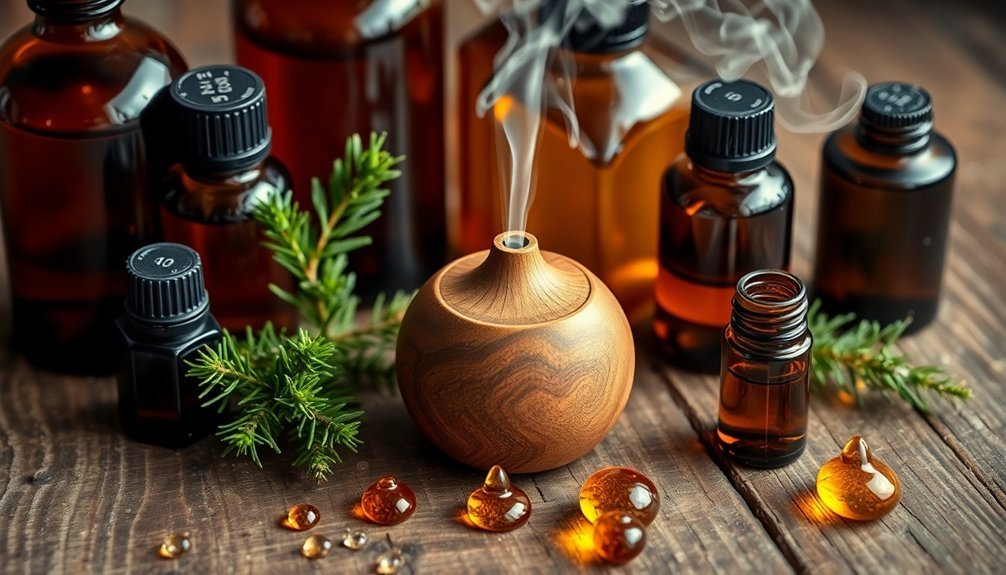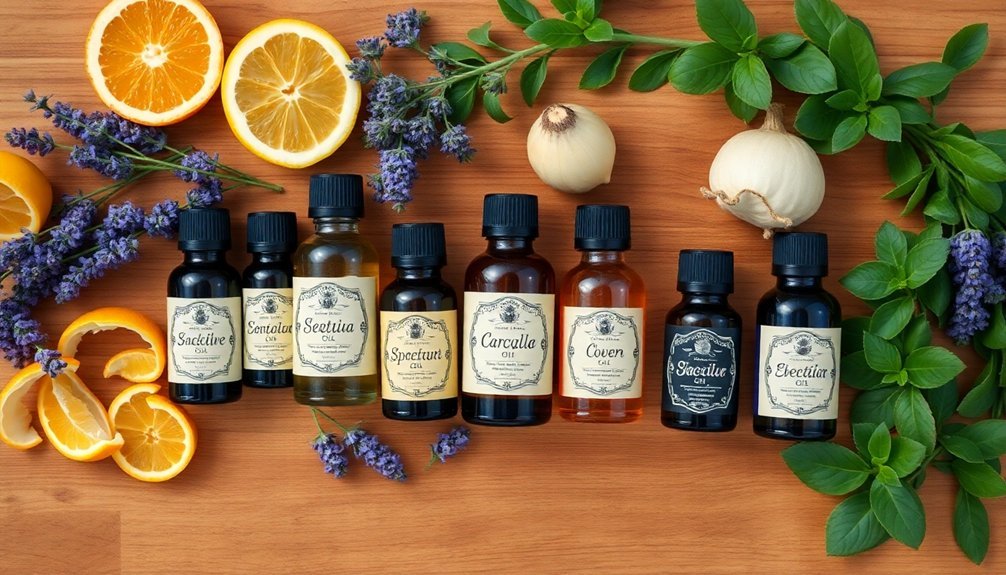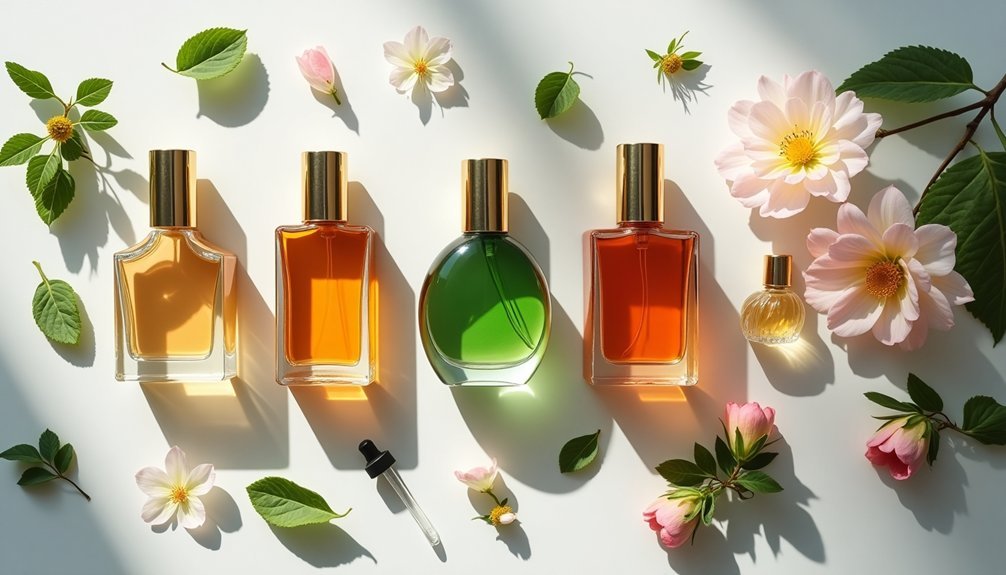To master perfume blending, you'll need to understand the four main scent families: Floral, Oriental, Woody, and Fresh. The fragrance wheel, created by Michael Edwards, helps you pair complementary scents using neighbor, opposite, and triangle techniques. Start with one dominant base note from your chosen family, then add lighter accents while keeping base notes at 5-10% of the blend. Testing combinations on your skin reveals how personal chemistry influences the final harmony, opening doors to endless creative possibilities.
Understanding the Fragrance Wheel: Your Scent Navigation Tool

While choosing a signature scent can feel overwhelming, the Fragrance Wheel serves as your essential navigation tool in the world of perfumes. Created by Michael Edwards in 1983, this visual guide organizes scents into four main families: Floral, Oriental, Woody, and Fresh, helping you understand how different fragrances relate to each other. The wheel reflects dynamic fragrance evolution as our perception of scents continues to develop over time.
You'll find the wheel particularly useful when pairing scents, as it offers three effective techniques: the Neighbor method for complementary subfamilies, the Opposite approach for contrasting combinations, and the Triangle technique for complex, harmonious blends.
Think of it like a color wheel for scents, where adjacent families blend seamlessly while opposite ones create dynamic contrasts. Whether you're new to fragrances or a seasoned enthusiast, the wheel helps you navigate the intricate world of perfume notes and combinations.
The Floral Family: A Symphony of Blooming Notes
Among the four main fragrance families on the wheel, the floral family stands as the most expansive and beloved category in perfumery. You'll find these scents prominently featured as heart notes, offering everything from single-flower compositions to complex bouquets.
The floral family divides into four distinct subfamilies: Floral Bouquets blend green and woody elements, Soft Florals embrace powdery sweetness, Floral Amber pairs with warm spices, and Floral Oriental introduces subtle spice notes. These fragrances are known for their rich aromatic quality.
While rose, jasmine, and peonies lead the pack, you'll also discover unique blooms like tuberose and neroli.
You'll find floral fragrances particularly fitting for spring and summer wear. Though traditionally associated with women's perfumes, they're increasingly appearing in men's scents, available in various forms from Eau de Parfum to solid perfumes.
Oriental and Amber Notes: Exploring Exotic Warmth

You'll discover a world of enchanting warmth in oriental fragrances, where rich spices blend seamlessly with sweet vanilla and precious resins.
These exotic scents trace their roots to ancient Middle Eastern perfumery traditions, creating complex aromas that evolve beautifully on your skin.
Whether you're drawn to the sweetness of vanilla-based orientals or the mysterious depth of amber compositions, you'll find these fragrances offer an irresistible combination of tradition and luxury. The two distinct categories of floral and woody oriental perfumes allow you to choose between lighter daytime scents and deeper evening aromas.
Rich Spices Meet Vanilla
When exotic spices intertwine with warm vanilla, they create the enchanting world of oriental and amber fragrances.
You'll discover a complex blend where spicy notes like cinnamon and ginger dance with sweet, resinous elements such as benzoin and labdanum. These combinations aren't just random – they're carefully crafted to evolve on your skin throughout the day.
As you wear these sophisticated scents, you'll notice how the initial burst of warmth transforms into honeyed heart notes, finally settling into a deep, lasting base.
You'll find variations to suit your style, from ambery orientals rich in sandalwood to soft orientals with delicate floral touches.
While they're particularly enchanting for evening wear and winter occasions, their versatile nature means you can find the perfect oriental blend for any moment.
Resins Through The Ages
Ancient civilizations treasured resinous amber fragrances as sacred luxuries, with Greeks, Egyptians, and Romans incorporating exotic spices and balsams into their ceremonial rituals. You'll find that modern amber fragrances don't actually contain amber stone but instead blend various resins and aromatics to create their distinctive warmth.
| Resin Type | Key Notes | Contribution |
|---|---|---|
| Benzoin | Smoky, Sweet | Adds leathery depth |
| Labdanum | Spicy, Woody | Creates rich foundation |
| Vanilla | Sweet, Warm | Provides comfort |
| Tonka Bean | Nutty, Sweet | Enhances complexity |
| Ambergris | Marine, Musky | Fixes other notes |
When you're exploring amber fragrances, you'll notice they evolve beautifully on your skin, starting with warm, inviting top notes before revealing their complex heart and settling into a deep, sensual base that lasts for hours.
Fresh and Citrus: The Art of Clean, Bright Blends
You'll find vibrant citrus notes like lemon, bergamot, and mandarin serving as essential building blocks in fresh fragrances, creating an instantly uplifting effect.
When combined with aquatic elements, these citrus components take on a new dimension that captures the essence of ocean breezes and coastal air.
These marine-inspired compositions often feature salt notes and ozonic accords that transport you to a day by the sea, making them perfect for warm weather wear.
Vibrant Citrus Building Blocks
At the heart of bright, fresh fragrances lies a vibrant family of citrus notes that serve as essential building blocks in modern perfumery.
You'll find bergamot offering elegant, fruity bitterness, while Sicilian lemon delivers an intense burst of tanginess. Orange notes range from sweet to bitter, with orange blossom adding sophisticated refinement.
When you're exploring citrus perfumes, you'll discover distinct families that showcase these notes differently.
Pure citrus fragrances like Dior Homme Cologne highlight zesty brightness, while citrus-floral blends like Chance Eau Fraîche create more complex compositions.
You can wear these versatile scents year-round, though they're especially invigorating in spring and summer.
Through layering techniques and custom blending, you'll be able to create your own signature combinations, whether you prefer a straightforward citrus burst or sophisticated woody-citrus blend.
Ocean-Inspired Scent Compositions
Ocean-inspired fragrances capture the essence of seaside adventures through three core elements: fresh marine accords, salty notes, and aquatic molecules like Calone.
You'll find these scents blend seamlessly with citrus, floral, and woody notes to create a balanced composition that's both stimulating and calming.
When exploring ocean-inspired perfumes, you'll discover these key characteristics:
- Fresh marine fragrances typically combine citrus and aquatic notes for that distinctive sea breeze effect
- Layering with amber or vetiver adds depth, mimicking sun-warmed sand
- Sea salt and driftwood notes provide authenticity to the maritime experience
- The versatile nature makes them suitable for both casual wear and office settings
These scents work exceptionally well in warm weather, offering a revitalizing escape that transports you to coastal memories with every wear.
Woody Essences: Creating Deep, Rich Foundations

While many fragrance families offer fleeting top notes, woody essences form the backbone of perfumery by creating deep, lasting foundations. You'll find these scents derived from nature's strongest elements: trees, resins, and mosses, creating warm, earthy compositions that anchor your fragrance.
| Woody Type | Key Notes | Best For |
|---|---|---|
| Woody Green | Cedar, Sage | Fresh Forest Feel |
| Woody Aromatic | Rosemary, Sandalwood | Classic Elegance |
| Woody Ambery | Amber, Patchouli | Evening Wear |
When you're exploring woody fragrances, you'll discover they're incredibly versatile. They can stand alone or complement other scent families, offering everything from crisp, verdant forest notes to deep, smoky leather accords. The key to their endurance lies in their composition – they interact uniquely with your skin chemistry, creating a lasting impression that evolves throughout the day.
The Fougère Blueprint: Balancing Fresh and Warm
Since its revolutionary debut in 1882 with "Fougère Royale," the fougère family has mastered the delicate balance between fresh and warm notes in perfumery.
You'll discover a sophisticated blend of lavender and bergamot in the top notes, while oakmoss and coumarin create an earthy heart. The base notes often feature vetiver and geranium for added depth.
While traditionally associated with men's fragrances, you'll now find fougère scents across the gender spectrum, from classics like Brut to modern interpretations like YSL's Libre.
- Aromatic fougères incorporate additional herbs and spices
- Perfect for year-round wear due to their balanced composition
- Suitable for both casual outings and formal occasions
- Contemporary versions often feature innovative twists with floral and animalic notes
Strategic Blending: Pairing Complementary Families

Mastering the art of fragrance blending requires a deep understanding of the fragrance wheel, a revolutionary tool developed by Michael Edwards.
You'll find that neighboring families on the wheel naturally complement each other, making it easier to create harmonious combinations.
To create balanced blends, you can pair soft oriental with citrus notes, or explore the relationship between oriental and water scents.
For more complex compositions, try selecting three subfamilies that form a triangle on the wheel. You'll discover that floral notes work beautifully with citrus or fruity accords, while woody scents pair excellently with florals or spices.
Remember to test your combinations on your skin, as personal chemistry plays an essential role.
Start with small amounts and adjust proportions until you achieve your desired blend.
Seasonal Scent Mapping: When to Wear Which Family
Beyond understanding how fragrances blend together, knowing when to wear specific scent families can enhance your perfume experience throughout the year.
As seasons change, you'll want to adapt your fragrance choices to complement the weather and atmosphere.
In spring, opt for light florals, zesty citrus, and fresh green notes that mirror nature's renewal.
When summer arrives, switch to aquatic and marine scents that capture ocean breezes and cooling effects.
- Choose light floral notes like rose and lavender for spring's mild temperatures
- Incorporate citrus elements year-round, adjusting concentration for seasonal warmth
- Select green notes in spring to complement the natural environment
- Embrace aquatic and marine scents during summer's peak heat
This seasonal approach guarantees your fragrance always feels appropriate and enhances your daily experience.
Building Your Signature Blend: Family Combinations

Creating your signature fragrance blend requires understanding how different scent families complement each other.
You'll find that floral and citrus combinations offer a fresh, balanced profile – think rose with bergamot for an uplifting spring scent. If you're seeking something more intense, try oriental and woody pairings like vanilla with sandalwood for a luxurious evening fragrance.
For a clean, robust scent, explore fresh and aromatic combinations by mixing citrus with herbs like lavender or mint.
Want sophistication? Consider chypre and fougère blends, which pair oakmoss with lavender and coumarin for versatile wear.
Remember to balance your composition across all note types – top notes for first impressions, middle notes for depth, and base notes for longevity.
This structure guarantees your signature blend evolves beautifully throughout the day.
Common Mistakes to Avoid When Mixing Scent Families
When mixing fragrances, you'll need to watch out for competing base notes that can create an overwhelming effect rather than a harmonious blend.
You shouldn't combine multiple strong scents from adjacent fragrance families, as they often fight for dominance and create an imbalanced result.
To maintain a balanced signature blend, it's crucial to pair one dominant base note with lighter, complementary accents from different fragrance families.
Overpowering Competing Base Notes
Although mixing base notes can create unique fragrance profiles, combining too many competing scents often leads to an overwhelming and muddled result. When working with base notes, you'll want to maintain a delicate balance of 5-10% in your overall blend.
Start with small amounts and adjust gradually to achieve the perfect harmony.
To avoid overpowering base notes in your fragrance:
- Choose base notes from complementary fragrance families that work in harmony
- Test your blend on skin or paper before finalizing the mixture
- Apply to moisturized skin at pulse points for peak development
- Let the fragrance dry naturally without rubbing, which can disrupt the layers
Remember to select rich, warm base notes that complement your middle and top notes while creating a strong foundation. This careful approach guarantees your fragrance maintains its sophistication without becoming overwhelming.
Adjacent Family Imbalance Issues
Despite their natural compatibility, adjacent scent families can create unexpected challenges when mixed improperly. You'll need to watch for redundant dominant notes, which can make your blend less interesting. For example, combining two fresh scents might overwhelm with citrus notes instead of creating complexity.
| Common Issue | Cause | Solution |
|---|---|---|
| Note Redundancy | Similar dominant notes | Adjust ratios carefully |
| Lack of Depth | Too much similarity | Add contrasting accent |
| Overwhelming Strength | Over-layering | Limit to 2-3 scents |
| Muddled Blend | Poor balance | Test combinations first |
To avoid these pitfalls, consider using the opposite family technique instead. By pairing fragrances from opposite sides of the wheel, you'll create more dynamic and sophisticated combinations. Always test your blends on a small scale before committing to a full application.
Frequently Asked Questions
How Long Do Different Scent Families Typically Last on Skin?
You'll find woody and oriental scents last longest (8+ hours), followed by floral notes (4-6 hours), while fresh and citrus fragrances fade quickest (2-4 hours). Your skin type affects these durations considerably.
Can Certain Scent Families Trigger Allergic Reactions More Than Others?
Yes, floral and oriental scent families tend to trigger allergic reactions more frequently due to their complex ingredients. You'll often find common allergens like lavender, musk, and synthetic compounds in these families.
Which Scent Families Are Best for People With Fragrance Sensitivity?
You'll likely find fresh and light floral scents most tolerable if you're sensitive to fragrances. These families typically contain fewer allergens, but you should always patch test first to guarantee safety.
Do Scent Families Smell Differently on Different Skin Tones?
Yes, your skin tone affects how fragrances develop. You'll notice deeper notes like oud and amber shine on darker skin, while lighter skin enhances fresher, citrus notes due to differences in melanin and pH levels.
How Do Temperature and Humidity Affect Different Scent Families?
You'll notice that heat intensifies lighter scents like citrus and florals, while cold weather brings out richer base notes. High humidity makes fragrances last longer, but low humidity causes them to fade quickly.
In Summary
You've now mastered the basics of fragrance families and how they work together. Don't be afraid to experiment with different combinations while keeping the fundamental rules in mind. Start with simple two-note blends and gradually work your way up to more complex compositions. Whether you're creating a signature scent or building a seasonal collection, you'll find endless possibilities within these scent families.





Leave a Reply